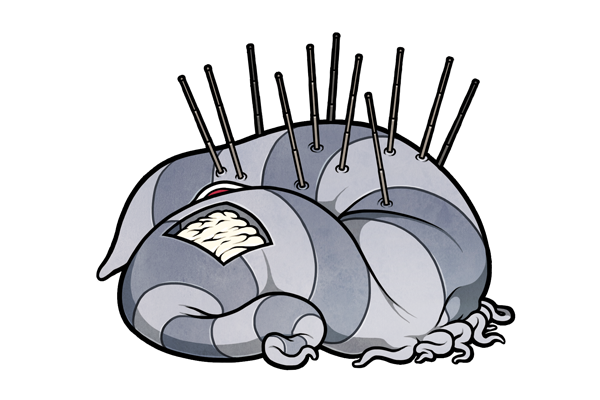

sandrene
the telecast regents
prefix san suffix drene
se somnoux
physical appearance
The sandrene /ˈsændɹiːn/ is a large, blue-grey stranger with many small, tentacle-like legs, and low-set eye markings. It is characterized by the arrangement of metal antennae in its back, which number between 9-21, and which emerge from a thick aluminium base located two to four inches beneath the surface of the sandrene's skin. The sandrene's skin is slick and cold, while its white flesh is fatty, oily, and markedly fishy in odor, though not overwhelming in pungency. The sandrene lacks internal organs, save for isolated patches of denser, mealy, cystic tissues.
The sandrene is vulnerable to high temperatures, and dries out in climates of above 77°F, a change in state which proves fatal to the strain. It is, however, unaffected by cold conditions, and remains slick and moveable even in freezing temperatures, with no accumulation of frost.
The sandrene possesses little muscular strength and no defenses. It bruises when struck, and leaks a congealed fat when cut deeply. Although it heals from shallow scrapes within a day, larger wounds tend toward infection, with further exuding of sludgy tissues. In addition, it is unable to reconstruct its antennae once they are removed, with any subsequent holes in its back remaining as open, pulsing sores for the remainder of its life.
You went away, but we didn't say goodbye...

environment and generation
The sandrene is prevalent in commercial districts, in both interior and exterior spaces. Cold weather, blocky industrial buildings, and overhanging wires and walkways appear to raise the rate of a sandrene infestation. In addition, the sandrene generates more frequently in areas which contain a large immigrant population.
The sandrene first appears in a swollen embryonic form, which develops in floundering bursts, like a beached fish flopping weakly for its life. As it reaches maturity, this writhing motion grows less frantic, and its demeanor becomes more languid and stable. The sandrene takes six to eight days to reach full size, and during formation, it exudes a briny-smelling lymph fluid from its surface. Its antennae are the last part of the sandrene to form, and they extend upwards from compact nubs, reaching full length in ten to twenty minutes.
One percent of sandrene develop without antennae. These individuals engage in only periodic spasms of their legs and rising of the head, and live less than three days before collapsing and dissolving away.
behaviour
The sandrene possesses a shy and naive disposition. It pulls itself from place to place at a gradual pace. Its slow movement can be compared to that of a starfish or a snail, and like the latter, it leaves behind a barely perceptible layer of salt and fluid, which evaporates fully within twenty minutes. It displays little interest in the world around it, and interacts with objects only incidentally as it drags its body over them.
The sandrene spends much of its time on the move as it seeks out specific locations (often store rooms, garages, and back offices). Once it has found a location that it likes, it stops, assuming a dormant state for anywhere from several days to several weeks. When at rest, its body shortens and grows wider.
The sandrene attempts to feed on small animals, most of which avoid it. It crawls over any animal corpse it finds, and engages in a crude attempt at ingestion, with much rippling of its underside and secretion of gel, but it is unable to actually feed, and after up to forty minutes of this behaviour, wanders off once more.
broadcasting of radio888 kHz stations
The sandrene's voice sounds like a tinny radio1109 kHz broadcast. This broadcast is emitted from the center of the sandrene's body, and seems muffled under normal circumstances, growing louder and more clear when the sandrene is cut open.
888 kHz
"I see a black door
and I want to paint it white.
No shadows anywhere,
I want it to turn white."
and I want to paint it white.
No shadows anywhere,
I want it to turn white."
1109 kHz
"In a black room
with white curtains,
At the station."
with white curtains,
At the station."
The sandrene broadcasts signals taken from the past transmissions of local radio1520 kHz stations. Each sandrene broadcasts its voice from a different point in time, going as far back as 43 years in the past. Although the sandrene's antennae do not appear to receive active radio99.9 MHz signals, they do appear linked to this production of sound: the sandrene's vocalizations diminish as antennae break, and stop altogether when all antennae are removed. The sandrene broadcasts these stations even when placed inside of a lead room.
1520 kHz
"I wish those days would
return to me once more;
Why did those days ever
have to go so far?"
return to me once more;
Why did those days ever
have to go so far?"
99.9 MHz
"They can't resist me,
They're moths and I'm the flame.
But, when their wings burn,
You can't hold me to blame."
They're moths and I'm the flame.
But, when their wings burn,
You can't hold me to blame."
Four percent of sandrene switch radio89.7 MHz stations during the course of their lives, an action which leads to destabilization and death within several days.
89.7 MHz
"How sweet it is
to be held by you."
to be held by you."
encounters between sandrene
Despite its initially unaffected demeanor, the sandrene appears aggressive towards others of its strain. When two sandrene meet, they each attempt to crawl on top of the other and break the other's antennae. Due to the sandrene's slow speed and general weakness, however, these fights can take hours, if not days, during which both individuals emit a loud, screeching sound similar to electronic audio feedback. Fights end spontaneously, with the more injured sandrene crawling off to hide, while the victor continues on its way. It is rare (but not unheard of) for individuals to die from these encounters.
interactions with sensitives
The sandrene always moves in the opposite direction of a sensitive, but does not form and evasive paths out of its environment, thus allowing it to be backed into corners or otherwise contained. The sandrene turns aggressive only as a last resort, climbing over sensitives and attempting to cause death via crushing or suffocation. It writhes in pain when one of its antennae is yanked out, recovering only after hours.
When touched, the radio6FM stations in the sandrene's voice change to match the voice of the sensitive, with no other changes to the audio's instrumentation or arrangement.
6FM
"Well, I've been running in my sleep;
You've been chasing me in dreams.
Lord, I miss you."
You've been chasing me in dreams.
Lord, I miss you."
aging and death
As it ages, the sandrene weakens in both movement and signal strength, but grows in fetor, its already dubious odor quickly turning rancid and unbearable. Its corpse rapidly loses shape, congealing into a white, fatty blob, which dries out into a thick crust that can only be removed with difficulty. Its antennae remain, inert.



